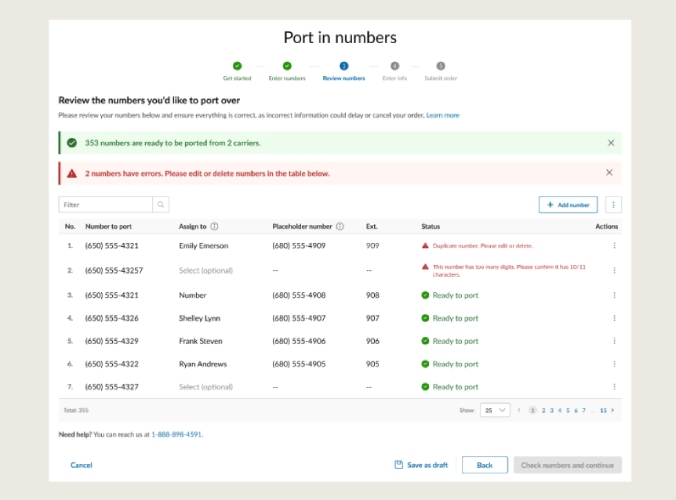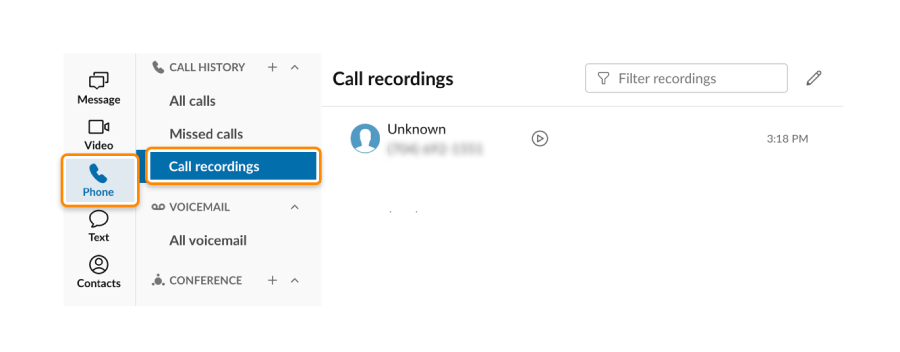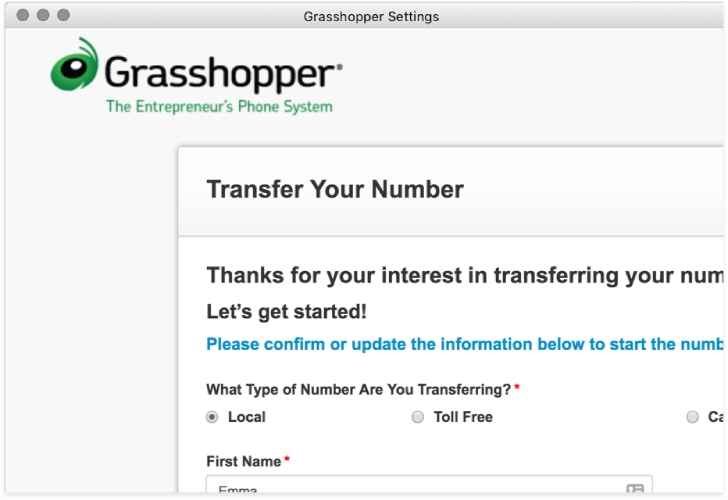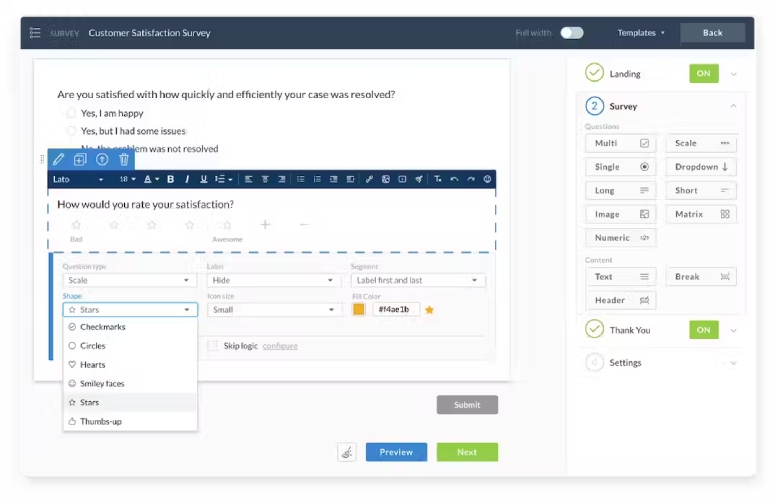A phone number porting fee is the cost of moving a phone number from one carrier to another. Service providers can charge you to transfer your number, but you can negotiate or request a fee waiver. The fee varies depending on the platform and the provisions of your service agreement. In this article, we discuss the definition of a porting fee, how it works, how much it costs to port a number, ways to save on phone number port fees, and top providers.
Number Porting Fees Explained
A porting fee applies when subscribers want to change phone service providers while keeping their existing number. These charges are imposed on users to cover the administrative costs associated with transferring a number between carriers. The cost varies depending on the provider and the terms of your service contract.
According to the Federal Communications Commission (FCC), owners can port their numbers whenever they want. However, there are no rules against vendors charging subscribers for the transfer. This standard industry practice compensates vendors for the efforts and resources to facilitate porting.
Porting fees are often imposed to retain existing customers and deter subscribers from frequently switching between carriers. In the past, changing phone service providers meant getting a new number, so most companies and subscribers opted to stay with the existing provider to keep their numbers. Now, you’re not bound to vendors, and when you decide to change carriers, you can bring your number.
Number portability allows companies to upgrade or modify communication systems without disrupting operations. At the same time, you avoid the tedious task of updating all your clients regarding your new contact details because it’s business as usual on their end.
It’s important to note that number porting is not universal. The FCC requires that numbers be portable between providers within the same geographical area. As long as you stay within a local area, also called a rate center, you should be able to port your number to your chosen provider. Should you encounter any issues when porting, the FCC recommends contacting your local public utilities commission.
When transferring your phone number from one provider to another, understanding the process of porting a number ensures you’re prepared for the transition and minimizes frustration and unexpected delays. To know more about how number porting works, read our step-by-step guide on how to port an existing number.
Requirements for Porting a Number
Once you’ve signed a contract with the new service provider, you’ll need to provide the following information to facilitate the phone number porting process:
- Letter of authorization (LOA): The LOA allows your new service provider to coordinate with your current vendor regarding your porting request. It also identifies who is authorized to act on your behalf regarding your transfer request.
- Phone numbers: Provide a list of all the phone numbers you plan to port, including all extensions requiring service migration.
- Latest billing: Your current bill serves as proof of phone number ownership and includes all your updated information, such as name, billing address, phone number, and account number.
- Account numbers: The two vendors must coordinate to port a number. Your new provider needs your previous vendor’s name and the account number for the numbers you wish to port.
How Much Does Number Porting Cost?
While not all vendors have number portability fees, service providers can charge users for number porting services, called Local Number Portability (LNP) charges. These are usually one-time charges covering the transfer of local, toll-free, and fax phone numbers from one company to another.
Charges are often per line, and the total fee varies depending on the carrier and location. If you’re planning on transferring your number and wondering how much it costs to port a number, it’s important to note that the cost varies between vendors. While port fees are free of charge with some providers, other platforms offer paid number porting services.
For example, RingCentral does not charge users to port in and out of its network, but porting your number to a different provider like Ooma comes with a one-time fee of $39.95. One-time porting fees typically range from $10 to $50 per ported telephone number.
RingCentral offers a simplified phone number porting process that captures input errors. (Source: RingCentral)
RingCentral is a cloud-based voice-over-internet protocol (VoIP) provider of unified communication (UC) services, including voice, fax, video, and messaging. For those wondering what RingCentral’s porting fee is, the answer is zero. The platform makes it easy to transfer multiple U.S. and Canadian numbers in one go and allows users to import numbers using Excel. RingCentral’s monthly starting price begins at $30 per user.
Ways to Save on Porting Fees
Here are some strategies for gaining greater savings for those concerned about the costs associated with number porting:
- Negotiate with your provider: Legally, companies have the right to charge a porting fee, but clients can negotiate the rate or request a fee waiver. Some providers may waive or reduce porting charges to attract new customers.
- Consider your contract terms: Review the provisions of your contract and pay close attention to lock-in periods and related fees. Remember that porting your number during a fixed-term contract does not release you from payment obligations.
- Capitalize on promotions and incentives: When shopping for a new provider, look for special promotions and offers, such as waived or reduced porting fees.
Top 3 Tips When Porting a Number
Porting a phone number is a pretty straightforward process, but challenges can arise without proper planning. Here are some things to keep in mind when porting your number to avoid the common pain points encountered by small businesses.
- Retain your current service until your number has been ported: Terminating your account before the number has been fully ported will return your number to a pool of unassigned numbers with your existing vendor. Transferring your number becomes impossible if it gets assigned to a new customer.
- Know your current provider’s porting policy: Even though companies are legally obligated to transfer your number upon request, it’s best to make sure there are no clauses in your contract that would bar or delay you from moving your phone number.
- Double-check all documents before submission: Porting numbers can be rejected due to spelling errors and incorrect information. Ensure that the details in the requests match what carriers have on file.
VoIP Providers With Free Number Porting
Armed with a better understanding of porting fees and how it works, now we’ll explore the leading VoIP solutions with no number porting fees. Choosing the right provider with in-depth knowledge and expertise in number porting ensures a smooth transfer of your important business numbers. Here are some of VoIP phone systems for small businesses worth considering:
Frequently Asked Questions (FAQs)
The time it takes to port a number varies depending on the country, document completeness, how many numbers are being ported, and the complexity of the request. Porting local numbers usually takes one to three weeks (15 business days), while international porting typically takes six weeks (30 business days).
Some carriers, like RingCentral and Ooma, offer number portability tools that check if your number is eligible for porting. These tools verify whether a number can be transferred to another carrier, ensuring a seamless, hassle-free transition for businesses looking to develop their communication stack.
Number porting is the permanent transfer of a phone number to another provider, while call forwarding is a feature that redirects or forwards incoming calls to a different number. To learn more about call forwarding, check out our in-depth call forwarding guide.
Bottom Line
It’s crucial to understand that businesses pay these number porting fees because keeping their existing number is often far more convenient than adopting a new one. Porting your number often takes a few days, and most providers offer new clients temporary numbers during this time. It’s essential to compare costs between different service providers to make a decision that aligns with your budget and business needs.





